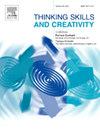The association between trauma exposure and creativity: The roles of trait resilience and psychological richness
IF 4.5
2区 教育学
Q1 Social Sciences
引用次数: 0
Abstract
While previous research has predominantly concentrated on the immediate impact of trauma on creativity, the current study delves into the enduring impact of traumatic experiences on creative thinking and behaviors. Moreover, this investigation explores the potential roles that trait resilience and psychological richness may play in the interplay between trauma and creativity. The data collection process involved administering questionnaires to assess participants’ trauma history, psychological richness, trait resilience, and creative activities and achievements. Additionally, the Alternative Uses Test was utilized to evaluate creative thinking. This study gathered data from a sample of 649 college students (228 males and 421 females). Findings from the path analysis model reveal that: (1) exposure to trauma can positively predict the four facets of creativity — fluency (β = 0.146), originality (β = 0.193), engagement in creative activities (β = 0.170), and creative accomplishments (β = 0.200); (2) trait resilience is positively related to both fluency (β = 0.198) and originality (β = 0.185), and it serves as a moderator in the relationship between trauma exposure and creative accomplishments and activities; and (3) psychological richness acts as a mediator in the effects of trauma exposure on originality (β = 0.012), creative accomplishments (β = 0.014), and the frequency of creative activities (β = 0.025). By extending the scope of existing research on trauma and creativity, this study offers valuable insights into the development of effective psychological interventions for individuals coping with trauma's aftermath.
创伤暴露与创造力的关系:特质弹性和心理丰富性的作用
先前的研究主要集中在创伤对创造力的直接影响上,而目前的研究则深入探讨了创伤经历对创造性思维和行为的持久影响。此外,本研究还探讨了特质弹性和心理丰富性在创伤与创造力相互作用中的潜在作用。数据收集过程包括管理问卷,以评估参与者的创伤史、心理丰富性、特质弹性、创造性活动和成就。此外,替代使用测试被用来评估创造性思维。本研究收集了649名大学生(228名男性,421名女性)的数据。通径分析结果表明:(1)创伤暴露对创造力的流畅性(β = 0.146)、原创性(β = 0.193)、创造性活动参与度(β = 0.170)和创造性成就(β = 0.200)有正向预测作用;(2)特质弹性与流利性(β = 0.198)和独创性(β = 0.185)均呈正相关,并在创伤暴露与创造性成就和活动的关系中起调节作用;(3)心理丰富性在创伤暴露对独创性(β = 0.012)、创造性成就(β = 0.014)和创造性活动频率(β = 0.025)的影响中起中介作用。通过扩展创伤和创造力的现有研究范围,本研究为开发有效的心理干预措施提供了宝贵的见解,以帮助个人应对创伤的后果。
本文章由计算机程序翻译,如有差异,请以英文原文为准。
求助全文
约1分钟内获得全文
求助全文
来源期刊

Thinking Skills and Creativity
EDUCATION & EDUCATIONAL RESEARCH-
CiteScore
6.40
自引率
16.20%
发文量
172
审稿时长
76 days
期刊介绍:
Thinking Skills and Creativity is a new journal providing a peer-reviewed forum for communication and debate for the community of researchers interested in teaching for thinking and creativity. Papers may represent a variety of theoretical perspectives and methodological approaches and may relate to any age level in a diversity of settings: formal and informal, education and work-based.
 求助内容:
求助内容: 应助结果提醒方式:
应助结果提醒方式:


